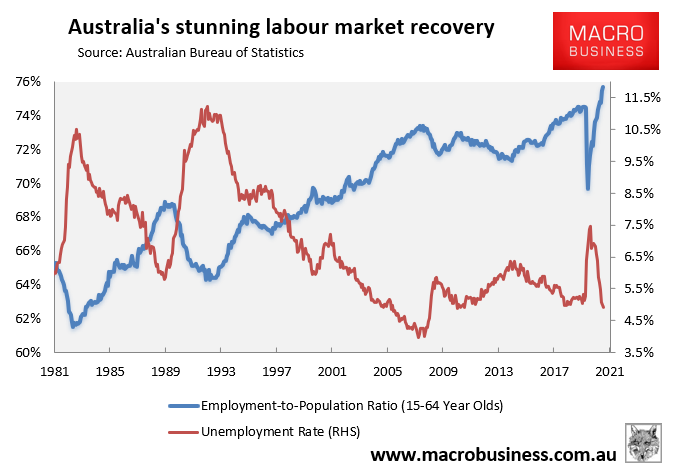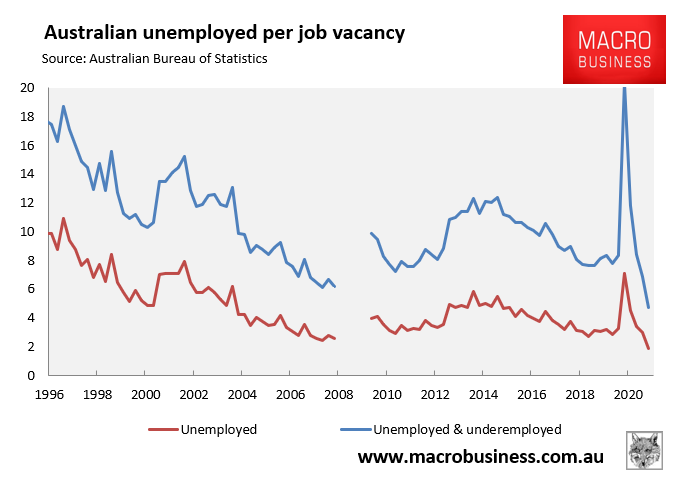In last week’s speech, RBA governor Phil Lowe explained how Australia’s pre-COVID mass immigration program played a direct role in Australia’s decade of anaemic wage growth by lifting labour supply:
Strong growth in labour demand was closely matched by a strong increase in labour supply. With both demand and supply rising, there was little need for the price – that is wages – to move…
[One] supply side factor is the ability that firms have had to draw on overseas workers when skills or workers were in short supply in Australia… This hiring dilutes the upward pressure on wages in these hotspots and it is possible that there are spillovers to the rest of the labour market. This hiring can also dilute the incentive for businesses to train workers to do the required job…
In conceptual terms, one can think of this ability to tap into the global labour market for workers that are in short supply as flattening the supply curve for these workers. A flat supply curve means that a shift in demand has only a small effect on prices, or in this case wages. In my view, this is one of the factors that has contributed to wages being less sensitive to shifts in demand than was once the case…
Strong labour demand was met with a strong supply response. The result was that the price of labour did not move much…
Phil Lowe went on to explain that if Australia’s international border remains closed to migrant workers, then this will place upward pressure on wages (other things equal).
Already we are starting to see the impacts. With 200,000 migrants not joining Australia’s labour force, the nation’s unemployment rate fell to its lowest level in decade in June to just 4.9%. The employment-to-population ratio for 15 to 65 year-olds also rose to its highest ever level of 75.7% – well above its pre-COVID level:
The number of job ads per unemployed in Australia has also fallen to its lowest level in records dating back to the early 1980s:
In yesterday’s board minutes, the RBA again noted that the lack of immigration is tightening the labour market and stated that a “tighter labour market” is required to deliver stronger wage growth:
Turning to the labour market, members noted that the unemployment rate had declined further and faster than expected earlier in the year, to pre-pandemic levels. Job vacancies had increased significantly and had reached multi-decade highs as a share of the labour force. Some industries where temporary visa holders had accounted for a sizeable share of employment in prior years, such as hospitality, had high levels of vacancies while employment remained below pre-pandemic levels. This suggested that the closure of Australia’s international borders was contributing to the difficulties faced by some firms in attracting workers at prevailing wages. However, new advertised positions were still being filled at a pace consistent with pre-pandemic patterns…
With indicators of future labour demand remaining strong and the participation rate around record high levels, it was likely that spare capacity in the labour market would continue to decline in subsequent quarters…
Members discussed the evidence that wages growth was stronger in local labour markets with an unemployment rate below 5 per cent. They also discussed the timing of the reopening of Australia’s international borders and its implications for labour supply. The decline in the number of temporary visa holders in Australia over the preceding year was consistent with reports of tightening labour market conditions in some sectors and regions…
Members therefore agreed that, ultimately, a tighter labour market would be required to overcome the inertia in wage- and price-setting norms and the focus on cost control established over much of the prior decade in Australia.
So basically, returning to pre-COVID immigration levels, whereby more than 180,000 migrant workers were imported into Australia every year, will undermine the RBA’s aims of achieving full employment and higher wage growth.
Economists left and right that still support mass immigration are now acting in direct contravention of the RBA’s stated policy goals.



